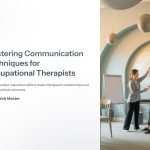 Effective communication is a crucial skill for occupational therapists, enabling them to build rapport with clients, collaborate with healthcare teams, and deliver personalized care. This guide explores key communication techniques, training strategies, and best practices to enhance interaction with patients and colleagues.
Effective communication is a crucial skill for occupational therapists, enabling them to build rapport with clients, collaborate with healthcare teams, and deliver personalized care. This guide explores key communication techniques, training strategies, and best practices to enhance interaction with patients and colleagues.


Understanding the Importance of Communication in Occupational Therapy
Communication in occupational therapy is more than just verbal exchange—it includes nonverbal cues, active listening, and patient education. Effective communication ensures that clients understand their treatment plans, feel motivated, and actively participate in their rehabilitation.
- Building trust: Patients respond better to therapists who communicate clearly and empathetically.
- Enhancing compliance: Proper communication helps patients adhere to therapy recommendations.
- Interprofessional collaboration: Occupational therapists work closely with doctors, nurses, and other professionals.
- Patient empowerment: Encouraging patients to express their needs fosters a sense of control over their recovery.
Core Communication Techniques for Occupational Therapists
1. Active Listening
- Maintain eye contact and use appropriate facial expressions.
- Summarize and reflect back what the patient has said.
- Avoid interrupting and give patients time to express themselves.
2. Empathy and Emotional Intelligence
- Show understanding through verbal affirmations.
- Acknowledge patients’ emotions and concerns.
- Adapt communication style based on patients’ emotional state.
3. Clear and Simple Language
- Use layman’s terms instead of medical jargon.
- Break down complex information into manageable parts.
- Encourage patients to repeat instructions for clarity.
4. Nonverbal Communication
- Pay attention to body language, gestures, and facial expressions.
- Use open and relaxed postures to convey approachability.
- Be mindful of cultural differences in nonverbal communication.
5. Motivational Interviewing
- Use open-ended questions to encourage discussion.
- Reflect patients’ statements to show understanding.
- Guide patients toward setting their own recovery goals.

Training Strategies to Improve Communication Skills
1. Role-Playing Exercises
Practicing real-life scenarios with colleagues helps therapists refine their verbal and nonverbal communication skills.
2. Feedback and Reflection
Receiving constructive criticism from supervisors or peers allows therapists to improve their communication techniques.
3. Continuing Education
Attending workshops and online courses on therapeutic communication ensures that therapists stay updated with the latest strategies.
4. Patient-Centered Communication Training
Learning to tailor communication styles to different patient populations (e.g., children, elderly, nonverbal patients) enhances effectiveness.
5. Simulation-Based Training
Using virtual reality or simulated patient interactions provides a safe environment to practice difficult conversations.

Overcoming Communication Barriers in Occupational Therapy
Common Barriers
- Language Differences: Use interpreters or translation apps.
- Cognitive Impairments: Simplify instructions and use visual aids.
- Hearing Impairments: Learn basic sign language or use written communication.
- Emotional Barriers: Provide a supportive and non-judgmental environment.
Solutions
- Adapt communication styles to individual patient needs.
- Utilize visual tools, gestures, and alternative communication methods.
- Foster a collaborative approach by involving caregivers and family members.

Case Studies: Effective Communication in Action
Case 1: Helping a Stroke Survivor Regain Independence
A therapist used motivational interviewing and step-by-step instructions to help a stroke survivor regain confidence in daily activities.
Case 2: Assisting a Nonverbal Child with Autism
By employing picture exchange communication systems (PECS) and positive reinforcement, the therapist facilitated nonverbal expression.
Case 3: Supporting an Elderly Patient with Dementia
Using reminiscence therapy and clear, repetitive instructions, the therapist improved the patient’s ability to follow daily routines.

Conclusion
Mastering communication techniques is essential for occupational therapists to provide high-quality care. By actively listening, using clear language, and adapting communication styles, therapists can build stronger relationships with patients and healthcare teams. Continuous training and self-reflection further enhance these skills, leading to better patient outcomes.
*Capturing unauthorized images is prohibited*


